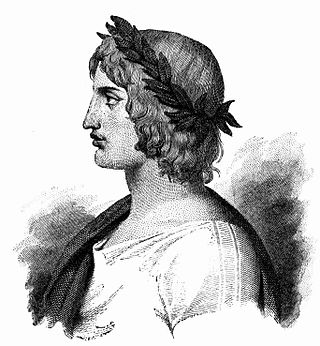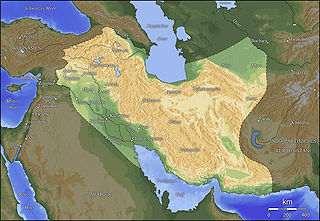Related Research Articles

Marcus Antonius, commonly known in English as Mark Antony, was a Roman politician and general who played a critical role in the transformation of the Roman Republic from a constitutional republic into the autocratic Roman Empire.
AD 35 (XXXV) was a common year starting on Saturday of the Julian calendar. At the time, it was known as the Year of the Consulship of Gallus and Nonianus. The denomination AD 35 for this year has been used since the early medieval period, when the Anno Domini calendar era became the prevalent method in Europe for naming years.

Year 70 BC was a year of the pre-Julian Roman calendar. At the time it was known as the Year of the Consulship of Pompeius and Crassus. The denomination 70 BC for this year has been used since the early medieval period, when the Anno Domini calendar era became the prevalent method in Europe for naming years.
This article concerns the period 169 BC – 160 BC.
This article concerns the period 179 BC – 170 BC.

Year 168 BC was a year of the pre-Julian Roman calendar. At the time it was known as the Year of the Consulship of Macedonicus and Crassus. The denomination 168 BC for this year has been used since the early medieval period, when the Anno Domini calendar era became the prevalent method in Europe for naming years.

Perseus was king of the ancient Greek kingdom of Macedon from 179 until 168 BC. He is widely regarded as the last king of Macedonia and the last ruler from the Antigonid Dynasty, as his defeat by Rome at the Battle of Pydna during the Third Macedonian War effectively ended Macedonia as an independent political entity.

Hellenistic Greece is the historical period of the country following Classical Greece, between the death of Alexander the Great in 323 BC and the annexation of the classical Greek Achaean League heartlands by the Roman Republic. This culminated at the Battle of Corinth in 146 BC, a crushing Roman victory in the Peloponnese that led to the destruction of Corinth and ushered in the period of Roman Greece. Hellenistic Greece's definitive end was with the Battle of Actium in 31 BC, when the future emperor Augustus defeated Greek Ptolemaic queen Cleopatra VII and Mark Antony, the next year taking over Alexandria, the last great center of Hellenistic Greece.

The Battle of Carrhae was fought in 53 BC between the Roman Republic and the Parthian Empire near the ancient town of Carrhae. An invading force of seven legions of Roman heavy infantry under Marcus Licinius Crassus was lured into the desert and decisively defeated by a mixed cavalry army of heavy cataphracts and light horse archers led by the Parthian general Surena. On such flat terrain, the Legion proved to have no viable tactics against the highly-mobile Parthian horsemen, and the slow and vulnerable Roman formations were surrounded, exhausted by constant attacks, and eventually crushed. Crassus was killed along with the majority of his army. It is commonly seen as one of the earliest and most important battles between the Roman and Parthian Empires and one of the most crushing defeats in Roman history. According to the poet Ovid in Book 6 of his poem Fasti, the battle occurred on 9 June.

Phraates IV was King of Kings of the Parthian Empire from 37 to 2 BC. He was the son and successor of Orodes II, and was given the throne after the death of his brother Pacorus I. Phraates IV soon murdered all his brothers, and also possibly his father. His actions alienated the Armenians and also some of his nobles, including the distinguished Monaeses, who fled to the Roman triumvir Mark Antony, but shortly returned and reconciled with Phraates IV.

Orodes II, was King of Kings of the Parthian Empire from 57 BC to 37 BC. He was a son of Phraates III, whom he murdered in 57 BC, assisted by his elder brother Mithridates IV. The two brothers quickly fell out and entered into a dynastic struggle, in which Orodes was triumphant.

Artavasdes II, also known as Artavazd II, was king of Armenia from 55 BC to 34 BC. A member of the Artaxiad dynasty, he was the son and successor of Tigranes the Great, who ascended the throne of a still powerful and independent state. His mother was Cleopatra of Pontus, thus making his maternal grandfather the prominent King of Pontus Mithridates VI Eupator. Like his father, Artavasdes continued using the title of King of Kings, as seen from his coins.

Pacorus I was a Parthian prince, who was the son and heir of Orodes II. The numismatist David Sellwood deduced that Pacorus ruled in c. 39 BC. It is uncertain whether Pacorus ruled alongside his father, or ruled independently. His wife was an unnamed Armenian princess, who was a sister of the Artaxiad king of Armenia, Artavasdes II.

Relations between the Roman and Iranian states were established c. 92 BC. It was in 69 BC that the two states clashed for the first time; the political rivalry between the two empires would dominate much of Western Asia and Europe until 628. Initially commencing as a rivalry between the Parthians and Rome, from the 3rd to mid-7th centuries the Roman Empire and its rival Sassanid Persia were recognized as two of the leading powers in the world.

The Battle of Callinicus was fought in 171 BC between Macedonia and the Roman Republic near a hill called Callinicus, close to the Roman camp at Tripolis Larisaia, five kilometres north of Larissa, the capital of Thessaly. It was fought during the first year of the Third Macedonian War. The Macedonians were led by their king, Perseus of Macedon, while the Roman force was led by the consul Publius Licinius Crassus. The Macedonians were supported by Cotys IV, the king of the Odrysian kingdom and his forces, Cretan mercenaries, and auxiliaries of mixed nationalities. The Romans had their Italian allies with them and were supported by soldiers provided by Eumenes II of Pergamon, as well as a force of Thessalian cavalry and Greek allies. The battle saw the deployment of troops with cavalry intermixed with light infantry. Although the battle was actually inconclusive because Perseus withdrew before it came to a conclusion, it was considered a Macedonian victory because the Romans suffered heavy casualties.

The Parthian Empire, also known as the Arsacid Empire, was a major Iranian political and cultural power centered in ancient Iran from 247 BC to 224 AD. Its latter name comes from its founder, Arsaces I, who led the Parni tribe in conquering the region of Parthia in Iran's northeast, then a satrapy (province) under Andragoras, who was rebelling against the Seleucid Empire. Mithridates I greatly expanded the empire by seizing Media and Mesopotamia from the Seleucids. At its height, the Parthian Empire stretched from the northern reaches of the Euphrates, in what is now central-eastern Turkey, to present-day Afghanistan and western Pakistan. The empire, located on the Silk Road trade route between the Roman Empire in the Mediterranean Basin and the Han dynasty of China, became a center of trade and commerce.
The Roman–Parthian Wars were a series of conflicts between the Parthian Empire and the Roman Republic and Roman Empire. It was the first series of conflicts in what would be 682 years of Roman–Persian Wars.

Julius Caesar's planned invasion of the Parthian Empire was a planned war of the Roman Republic against the Parthian Empire. The assassination of Julius Caesar in 44 BC prevented the invasion from taking place.

Augustus' Eastern policy represents the political-strategic framework of the eastern imperial borders of the Roman Empire at the time of Augustus' principate, following the occupation of Egypt at the end of the civil war between Octavian and Mark Antony.